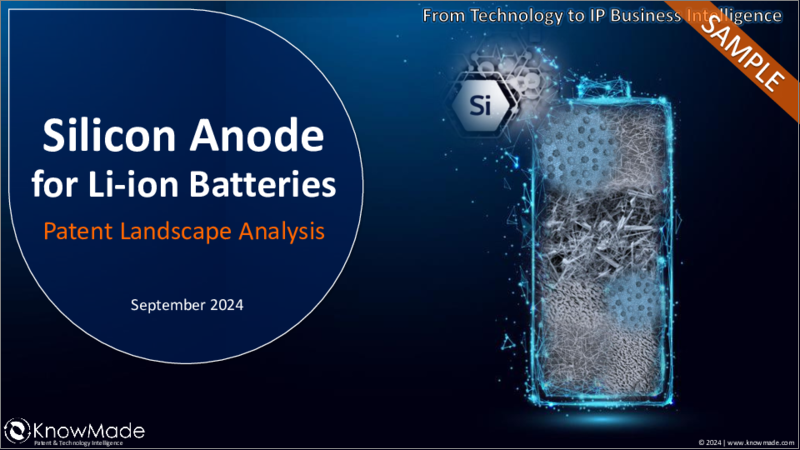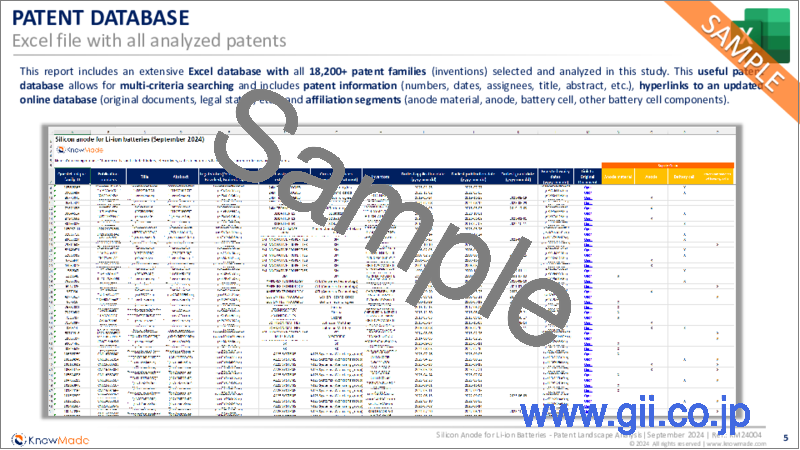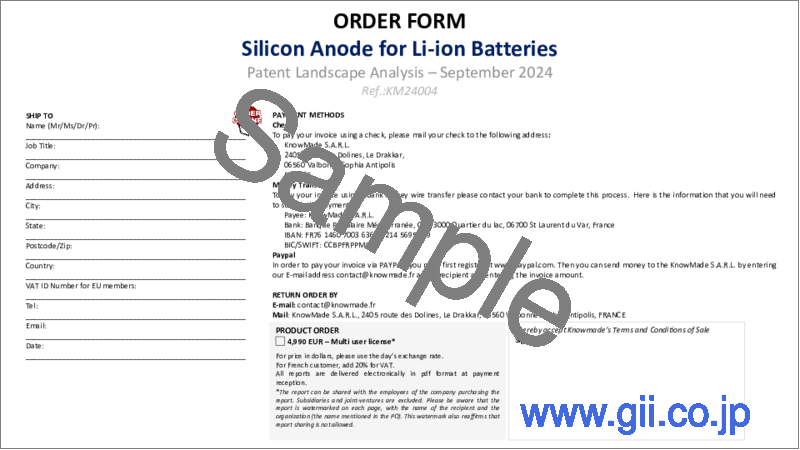|
|
市場調査レポート
商品コード
1564672
リチウムイオン電池用シリコン負極 - 特許情勢の分析(2024年)Silicon Anode for Li-ion Batteries - Patent Landscape Analysis 2024 |
||||||
|
|||||||
| リチウムイオン電池用シリコン負極 - 特許情勢の分析(2024年) |
|
出版日: 2024年09月30日
発行: KnowMade
ページ情報: 英文 PDF >100 slides, Excel file >18,200 Patent Families
納期: 即日から翌営業日
|
全表示
- 概要
- 目次
リチウムイオン電池のシリコン系負極の可能性が認識されたことで、この技術を市場に投入するために多額の投資が行われるようになりました。
リチウムイオン電池のシリコン系負極は、より高いエネルギー密度、より大きな重量容量と体積容量、適切な熱力学的リチウム化ポテンシャル、より高い平均電圧など、優れた電気化学的性能を提供します。
今日、リチウムイオン電池におけるシリコン系負極の使用は現実のものとなりつつあり、シリコン負極のスタートアップには数十億米ドルが流れ(IDTechEx、2021年)、リチウムイオン電池用シリコン負極材料の市場規模は2034年までに240億米ドルに達すると予測されています(IDTechEx、2024年)。Advano、Sila Nanotechnology、Elkem、Group14、NanoGraf、OneD Materials、Nexeonなどの複数の材料メーカーがリチウムイオン電池用シリコン活物質の商業生産を発表しています。同様に、Amprius、Sionic Energy(旧NOHMS)、Farasis Energy、Enovix、StoreDot、Samsung、Panasonic、PPES(ToyotaとPanasonicの合弁企業)、Murata、Enevate/EnerTechなどの複数の電池メーカーがシリコン負極リチウムイオン電池の商業利用を発表しています。Teslaは2019年に電池メーカーのMaxwell Technologiesを、2021年に電池スタートアップのSiLionを買収しました。同年、PPESとNexeonはシリコン負極の開発に焦点を当てた提携を発表し、StoreDotはEVE Energyと戦略的枠組み合意を結ぶ一方、電気自動車向けにStoreDotのXFCリチウムシリコンセルの商業化を加速するためにGroup14 Technologiesと提携しました。さらに、Daimler、Porsche、GMなどの自動車OEMはシリコン負極の可能性を認識し、シリコン負極企業に投資したり提携したりしています。
当レポートでは、リチウムイオン電池用シリコン負極業界について調査分析し、技術と知的財産(IP)における特許情勢や主要企業の戦略に関する情報を提供しています。



レポートで取り上げる企業(一部)
LG Chem/LG Energy Solution、Panasonic/Sanyo、Samsung、Murata Manufacturing/Sony、Toyota、ATL(Amperex Technology)、COSMX/COSLIGHT、Guoxuan High Tech Power Energy/Gotion、CATL(Contemporary Amperex Technology Ltd)、Global Graphene、SVOLT/Fengchao Energy Technology、General Motors、NEC、SK Group、Enevate、Resonac(Showa Denko/Hitachi Chemical)、Shanshan Energy Technology、Mitsubishi Chemical、BYD、EVE Energy、Bosch/SEEO、A123 Systems(Wanxiang group)、Sunwoda、Nissan、Tafel New Energy Technology/Zenergy、BTR New Energy Material、Amprius/Berzelius、Nexeon、Mitsui Mining & Smelting、Envision/AESC、Tinci Materials Technology、TDK、Hitachi 、JEVE(Tianjin EV Energy)、Huawei、Hyundai/Kia、WeLion New Energy Technology、Wacker Chemie、BAK Battery、Hitachi Maxell、GS Yuasa、Mitsui Chemicals、Tianmu Energy Anode Material、CALB(China Aviation Lithium Battery)、Yinlong Energy、Furukawa、Toshiba、Kaijin New Energy Technology、Smoothway Electronic Materials、Kunlunchem、Chery Automobile、Fujifilm、MU Ionic Solutions、Ube Corporation、Shin Etsu Chemical、Sumitomo Electric Industries、MGL New Materials、Sound Group、Zeon、FAW(China First Automobile Works)、BMW、Umicore、Sekisui Chemical、Capchem Group、Novolyte Technologies、その他の
目次
イントロダクション
- レポートの背景と目的
- 調査範囲
- Excelデータベース
- このレポートをよりよく理解するためのIPの基礎知識
- 電池分野における課題
- シリコン負極の主な利点と欠点
- シリコン負極リチウムイオン電池の主な課題と改善策
エグゼクティブサマリー
特許情勢の概要
主要動向とIP企業
- 特許公開と主な特許出願人の時系列的変化
- 特許公開の推移:国別
- 主な特許譲受人:パテントファミリー数別
- 主な特許出願人:企業分類別、原産国別
- 特許情勢に携わる主要スタートアップとピュアプレーヤー
- 主要IP企業のタイムライン
- 2021年以降のIP企業と新規参入企業
- 主要IP企業:サプライチェーンセグメント別(負極材料、負極、バッテリーセル)
- 特許の現在の法的ステータス(許可済み、申請中、失効)
- 主な譲受人のIPリーダーシップと2021年からの進化
- 主要企業の特許の地理的範囲
- 主な出願人のIP戦略(国内戦略 vs. 世界戦略)
- 主要IP企業と新規参入企業
主要企業の近年の特許活動
- Samsung、LG Chem/LG Energy Solution、Panasonic/Sanyo、ATL、COSMX、Nexeon、Enevate、Ionobell、Enwires
スタートアップとピュアプレーヤーの考察
- シリコン負極電池の特許情勢に関与する290社以上のスタートアップとピュアプレーヤーのマッピング
- 中国のスタートアップとピュアプレーヤー
- 韓国のスタートアップとピュアプレーヤー
- 日本のスタートアップとピュアプレーヤー
- 北米のスタートアップとピュアプレーヤー
- 欧州のスタートアップとピュアプレーヤー
- その他(台湾、イスラエル、インド、シンガポール、オーストラリアなど)
2021年以降のIP新規参入企業の考察
- 2021年以降にシリコン負極電池に関連する最初の特許を公開した650社以上のIP新規参入企業のマッピング
- 中国のIP新規参入企業
- 韓国のIP新規参入企業
- 日本のIP新規参入企業
- アメリカのIP新規参入企業
- 欧州のIP新規参入企業
- その他(台湾、カナダ、インドなど)
付録
Knowmadeのプレゼンテーション
Who are the key players and newcomers in the global IP race for the promising silicon anode-based Li-ion batteries?
KEY FEATURES:
- PDF >100 slides
- Excel file >18,200 patent families
- Global patenting trends, including time evolution of patent publications, countries of patent filings, etc.
- Main patent assignees and IP newcomers in the different segments of the supply chain.
- Key players' IP position and the relative strength of their patent portfolio.
- Patents categorized by categorized by supply chain segments (materials, anode, battery cell, other battery components).
- Recent patenting activities of key players.
- Focus on startups, pure players, and IP newcomers.
- Excel database containing all patents analyzed in the report, including patent segmentations and hyperlinks to an updated online database.
The recognized potential of the silicon-based anode for Li-ion batteries has led to significant investments in bringing this technology to market
Silicon-based anodes in Li-ion batteries offer superior electrochemical performance, including higher energy density, greater gravimetric and volumetric capacity, suitable thermodynamic lithiation potentials, and higher average voltage.
Today, the use of silicon-based anodes in Li-ion batteries is becoming a reality, with billions od dollars flowing into silicon anode start-ups (IDTechEx, 2021) and a market for silicon anode material for Li-ion batteries projected to reach $24 billion by 2034 (IDTechEx, 2024) . Several material manufacturers, such as Advano, Sila Nanotechnology, Elkem, Group14, NanoGraf, OneD Materials, and Nexeon, have announced the commercial production of silicon active materials for Li-ion batteries. Likewise, several battery manufacturers have announced the commercial availability of silicon anode Li-ion cells, including Amprius, Sionic Energy (formerly NOHMS), Farasis Energy, Enovix, StoreDot, Samsung, Panasonic, PPES (a joint venture between Toyota and Panasonic), Murata, and Enevate/EnerTech. In the automotive sector, there have been significant strategic acquisitions and partnerships. Tesla acquired battery manufacturer Maxwell Technologies in 2019 and battery start-up SiLion in 2021. That same year, PPES and Nexeon announced a partnership focused on silicon anode development, and StoreDot entered into a strategic framework agreement with EVE Energy, while partnering with Group14 Technologies to accelerate commercialization of StoreDot's XFC lithium-silicon cells for electric vehicles. Additionally, automotive OEMs such as Daimler, Porsche, and GM have recognized the potential of silicon anodes and have invested in and partnered with silicon anode companies.
In this highly competitive and dynamic environment, it is increasingly crucial to have a strong understanding of the patent landscape and the strategies of key players in technology and intellectual property (IP) . To meet this need, Knowmade is releasing a new Silicon Anode Batteries Patent Landscape report, which aims to clarify the current positions of IP players, analyze their IP strategies, and reveal where industry leaders, newcomers, and start-ups are focusing their R&D efforts.

A dynamic IP landscape
IP competition analysis should reflect the vision of players with a strategy to enter and develop their business in the silicon anode Li-ion battery market. In this report, Knowmade's analysts provide a comprehensive overview of the competitive IP landscape and latest technological developments in this field. The report covers IP dynamics and key trends in terms of patents applications, patent assignees, filing countries, and patented technologies. It also identifies the IP leaders, most active patent applicants, and new entrants in the IP landscape. The report also sheds light on under-the-radar companies and new players in this field.

Evolution of leading players' positions and entry of new patent applicants
LG Chem/LGES is leading the silicon anode battery patent landscape, with strong IP competition from Samsung, Murata, Panasonic/Sanyo, and Toyota. Additionally, we have identified over 290 start-ups and pure players involved in the patent landscape, and more than 650 new entrants who filed their first silicon anode-related patents in 2021 or later, most of whom are Chinese entities. In dedicated sections of the report, we focus on the IP portfolios held by key players, start-ups, and newcomers from various countries.

Useful Excel patent database
This report also includes an extensive Excel database with all patents analyzed in this study, including patent information (numbers, dates, assignees, title, abstract, etc.) and hyperlinks to an updated online database (original documents, legal status, etc.), and affiliation segments (anode material, anode, battery cell, other battery cell components).
Companies mentioned in the report (non-exhaustive)
LG Chem/LG Energy Solution, Panasonic/Sanyo, Samsung, Murata Manufacturing/Sony, Toyota, ATL (Amperex Technology), COSMX / COSLIGHT, Guoxuan High Tech Power Energy / Gotion, CATL (Contemporary Amperex Technology Ltd), Global Graphene, SVOLT / Fengchao Energy Technology, General Motors, NEC, SK Group, Enevate, Resonac (Showa Denko / Hitachi Chemical), Shanshan Energy Technology, Mitsubishi Chemical, BYD, EVE Energy, Bosch/SEEO, A123 Systems (Wanxiang group), Sunwoda, Nissan, Tafel New Energy Technology / Zenergy, BTR New Energy Material, Amprius / Berzelius, Nexeon, Mitsui Mining & Smelting, Envision / AESC, Tinci Materials Technology, TDK, Hitachi , JEVE (Tianjin EV Energy), Huawei, Hyundai/Kia, WeLion New Energy Technology, Wacker Chemie, BAK Battery, Hitachi Maxell, GS Yuasa, Mitsui Chemicals, Tianmu Energy Anode Material, CALB (China Aviation Lithium Battery), Yinlong Energy, Furukawa, Toshiba, Kaijin New Energy Technology, Smoothway Electronic Materials, Kunlunchem, Chery Automobile, Fujifilm, MU Ionic Solutions, Ube Corporation, Shin Etsu Chemical, Sumitomo Electric Industries, MGL New Materials, Sound Group, Zeon, FAW (China First Automobile Works), BMW, Umicore, Sekisui Chemical, Capchem Group, Novolyte Technologies, and more.
TABLE OF CONTENTS
INTRODUCTION
- Context & objectives of the report
- Scope of the report
- Excel database
- Basic knowledge of IP to better understand this report
- Challenges in battery field
- Main advantages and drawbacks of silicon anode
- Main challenges and improvement solutions for silicon anode lithium-ion battery
EXECUTIVE SUMMARY
PATENT LANDSCAPE OVERVIEW
Main trends and IP players
- Time evolution of patent publications and main patent applicants
- Time evolution of patent publications by country
- Main patent assignees according to the number of their patent families
- Main patent assignees by companies' typology and originating countries
- Main start-ups and pure players involved in the patent landscape
- Timeline of main IP players
- Historical IP players and new entrants since 2021
- Main IP players by supply chain segments (anode material, anode, battery cell)
- Current legal status of patents (granted, pending, dead)
- IP leadership of main assignees and evolution from 2021
- Geographical coverage of main players' patents
- IP strategy of main patent applicants (domestic strategy vs. global strategy)
- Key IP players and newcomers
Recent patenting activity of key players
- Samsung, LG Chem/LG Energy Solution, Panasonic/Sanyo, ATL, COSMX, Nexeon, Enevate, Ionobell, Enwires
Focus on start-ups and pure players
- Mapping of 290+ startups and pure players involved in the silicon anode battery patent landscape
- Chinese startups and pure players
- South Korean startups and pure players
- Japanese startups and pure players
- North American startups and pure players
- European startups and pure players
- Others (Taiwanese, Israeli, Indian, Singaporean, Australian, etc.)
Focus on IP newcomers since 2021
- Mapping of 650+ IP newcomers that published their first patent related silicon anode batteries in 2021 or later.
- Chinese IP newcomers
- South Korean IP newcomers
- Japanese IP newcomers
- American IP newcomers
- European IP newcomers
- Others (Taiwanese, Canadian, Indian, etc.)
ANNEX
- Methodology for patent search, selection and analysis
- Terminology





